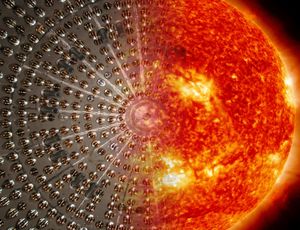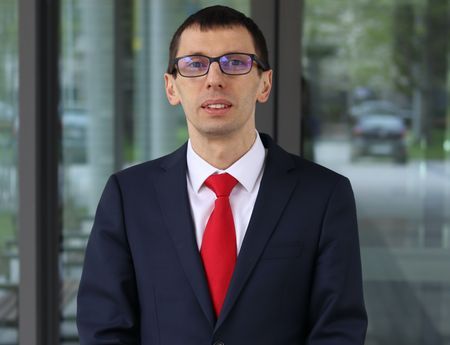
After more than ten years from the beginning of their reseasrch into the Sun, which provided the understanding of how the power mechanism of our star works at a level of detail never reached before, the BOREXINO experiment team working at the underground laboratories Gran Sasso in the vicinity of Rome published the compendium of their findings on solar neutrinos.
With this publication in Nature, BOREXINO crowns a long history of measurements and experimental investigations, which enabled the researchers to investigate the mechanism of energy production in the Sun in detail on the one hand, and, on the other hand, to study (from a few MeV down to less than 1 MeV) the so-called neutrinos oscillation phenomenon, i.e. the transformation of neutrinos from one type (flavour) into another, in the low energy region.
The BOREXINO instrument has been used continuously since 2007 to detect solar neutrinos. These data can be used to analyse the processes responsible for energy production in the Sun. The properties of the neutrinos themselves can also be investigated with the BOREXINO data. "We cannot take a look inside the sun’s core with conventional astronomical methods - we only see the surface of the sun in all wavelength ranges of electromagnetic radiation. Only neutrinos allow us to look directly at nuclear fusion in which energy is generated, thanks to which, among others, life exists on the Earth" – explained Prof. Marcin Wójcik, the coordinator of the Polish group of physicists from the Jagiellonian University participating in the experiment.
Neutrinos are probably the most common elementary particles in the Universe. They are formed during a number of processes, such as, radioactive decays, nuclear fusion in the core of stars, or in supernovae explosions. Billions of solar neutrinos penetrate through each our finger tip every second - completely unnoticed and undisturbed. This property of penetrating matter, however, makes their detection extremely difficult. Only large volume detectors, in which a few of the huge number of crossing neutrinos do interact with matter, can be used for neutrino measurements. One of these detectors is BOREXINO. In order to be able to recognize the few neutrino interactions, the levels of natural radioactivity in the BOREXINO apparatus had to be decreased by several orders of magnitude. To be shielded against cosmic radiation, the detector is located under a 1400-metre deep rock layer in the world’s largest underground laboratory, Laboratori Nazionali del Gran Sasso in Italy.
“BOREXINO has shown such an impressive level of radiopurity that it gained a unique and unmatched position among many low background experiments run nowadays. A group of physicists from the Jagiellonian University made the dominant contribution to achieving the unprecedentedly low BOREXINO detector background. This special feature has been the key to obtaning the invaluable data accumulated in more than a decade of operation” - commented Prof. M. Wójcik.
The Sun is a constant source of a large neutrino flux. In its core, for billions of years, hydrogen has been converted into helium in a sequence of nuclear reactions initiated by the fusion of two protons, namely proton-proton chain reaction. This releases the energy which is the main source of the solar energy.
In fact, the BOREXINO detector was designed to measure only the flow of monoenergetic 7Be neutrinos. However, it has gradually widened its experimental sensitivity, to cover the entire range of neutrinos from the whole sequence of the proton-proton chain. The concurrent, real-time and precise measurement of the neutrinos fluxes dubbed pp, 7Be, pep and 8B in a single experiment allows BOREXINO to explain the work of the Sun, putting a definitive end to the centuries-old question about the mechanism that makes it shine for billions of years.
At the same time, through the comparison of these experimental data of very high quality and accuracy with the forecasts of the Standard Solar Model, BOREXINO unquestionably demonstrates the existence of the oscillation between neutrinos of different flavour in the low energy region, known as the MSW (Mikheyev-Smirnov-Wolfenstein) effect. In particular, BOREXINO emphasizes in a completely autonomous way, using only its own data, the peculiar transition between the two regimes of “vacuum” and “matter”, which is the signature of the MSW effect.
“Neutrinos, moving at speeds close to the speed of the light, have the characteristics of changing back and forth between three different “families” during their flight - the so-called neutrino oscillations. This transformation depends on whether the neutrinos fly through empty space or through the dense matter, like the one which exists in the interior of the Sun” - explained Prof. M. Wójcik.
The results described in this publication represent the first complete study of the solar proton-proton chain obtained through neutrino detection in a single detector and with a uniform data analysis procedure.
BOREXINO will record further neutrino data until at least 2020. Scientists are working hard to understand whether the data could bring them to another discovery: the detection of neutrinos from the CNO cycle. The CNO cycle is another nuclear fusion process that is expected to be responsible for the energy production in stars that are heavier than the Sun. In the Sun, it could be a secondary process and, accordingly, difficult to detect. About 99% of the solar energy is generated as a result of nuclear reactions in the proton-proton cycle. The remaining 1% of the solar energy is probably generated due to the CNO process. The fact that it actually takes place in nature is so far only a theoretical prediction.
BOREXINO stems from the intense cooperation among physicists from Italy, Germany, France, Poland, the United States and Russia. Poland is represented by a group of Kraków researchers from the Department of Experimental Computer Physics at the Faculty of Physics, Astronomy and Applied Computer Science of the Jagiellonian University, coordinated by Prof. Marcin Wójcik.
Neutrino Group at Jagiellonian University Cracow:
http://zdfk.if.uj.edu.pl
Borexino Experiment:
http://borex.lngs.infn.it





